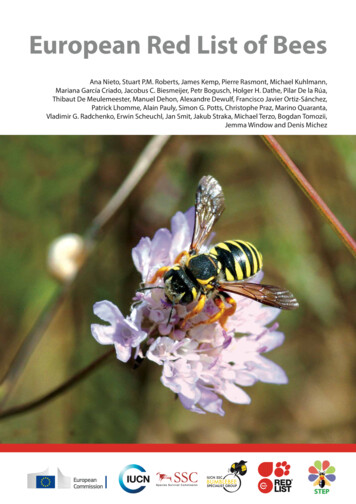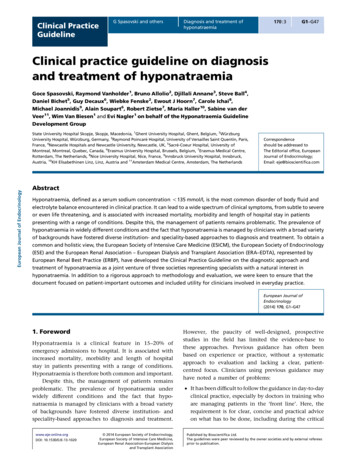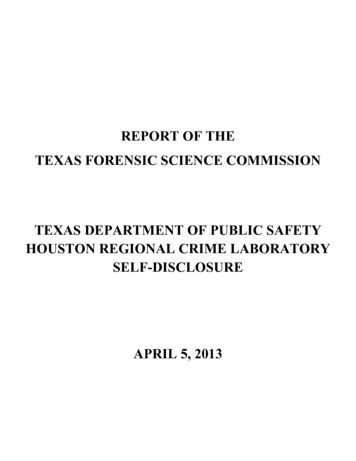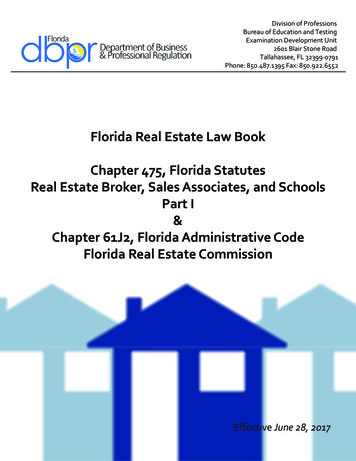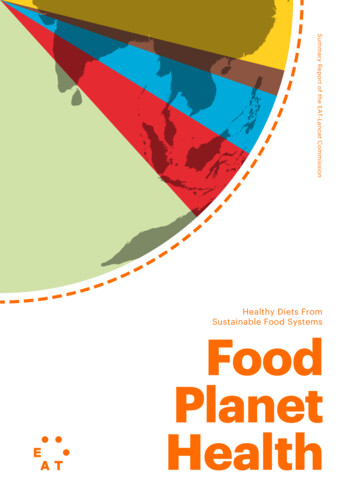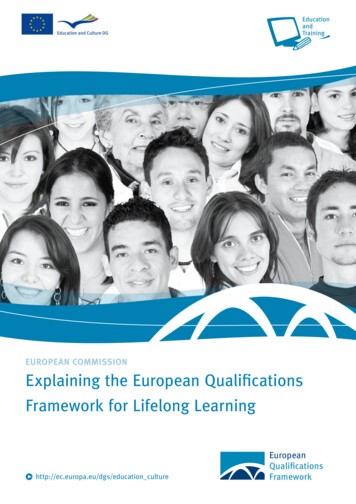
Transcription
European commissionExplaining the European QualificationsFramework for Lifelong Learninghttp://ec.europa.eu/dgs/education cultureEuropeanQualificationsFramework
Europe Direct is a service to help you find answersto your questions about the European UnionFreephone number (*):00 800 6 7 8 9 10 11(*) Certain mobile telephone operators do not allow access to 00 800 numbers orthese calls may be billed.More information on the European Union is available on the Internet (http://europa.eu).Cataloguing data can be found at the end of this publication.Luxembourg: Office for Official Publications of the European Communities, 2008 European Communities, 2008Reproduction is authorised provided the source is acknowledged.Printed in BelgiumP rintedon white chlorine - free paper
EXPLAINING THEEUROPEAN QUALIFICATIONS FRAMEWORKFOR LIFELONG LEARNINGEUROPEAN COMMISSIONEducation and CultureLifelong Learning: Education and Training policiesCoordination of Lifelong Learning Policies
EXPLAINING THE EUROPEAN QUALIFICATIONSFRAMEWORK FOR LIFELONG LEARNINGKey questions and answers1This note is written for those policy makers and expertswho are involved in implementing the EQF. The noteis the first in a series of EQF reference documentssupporting the implementation of the EQF.The EQFThe proposal for the European QualificationsFramework was launched by the European Commissionin September 2006. This recommendation outlinesan overarching framework to be set up in Europeto facilitate comparison of qualifications andqualifications levels in order to promote geographicaland labour market mobility as well as lifelonglearning. The core of the framework consists of 8qualifications levels described through learningoutcomes (knowledge, skills and competence).Countries are invited to relate their nationalqualifications levels to the neutral referenceestablished by the EQF. Following the adoption bythe European Parliament and Council (December2007), a process of implementation will start in 2008.Those countries deciding to go along with the EQF(it is a voluntary process) will be asked to do thisin two stages. The first stage – referring nationalqualifications levels to the EQF – should be completedby 2010. The second – introducing a reference tothe EQF in all new certificates – should be completedby 2012.EQF – new perspectives, new approachesThe EQF represents a new approach to Europeancooperation in the field of qualifications. Theintroduction of a set of learning outcomes basedreference levels/descriptors spanning all forms ofqualifications and the entire range of qualificationslevels have not been attempted previously. Successfulimplementation of the EQF therefore requires thateverybody involved shares a clear understanding of:1 The note has been written by Jörg Markowitsch, Karin Luomi-Messerer and SonjaLengauer of 3s Research Laboratory, Vienna and Jens Bjornavold, Cedefop. MichaelGraham, Georg Hanf and Mike Coles have worked on the text and added comments. The objectives and main intended functions of theframework; the principles and logic applied when defining theframework (how were the descriptors constructed,how should they be read?); the requirements to implementation (in terms ofstakeholder involvement, transparency, qualityassurance and peer review).This note – by answering 12 frequently asked questions– concentrates on explaining the basic principles andlogic of the European Qualifications Framework. Thenote addresses those policy makers and experts whoare involved in the implementation of the EQF (andcorresponding frameworks and solutions) at national,sectoral or regional level.The following questions – which can be read separately– are included and explained:1. Why is the EQF called a ‘Meta-framework’?2. What are the principles behind the EQF descriptorsand what is the significance of their wording?3. What is meant by ‘Knowledge, Skills andCompetence’ and why do we use these terms?4. Why aren’t there more dimensions as in otherframeworks?5. Isn’t competence the overall notion for all learning?Isn’t the EQF a framework of competences?6. Is it possible to relate a qualification to differentlevels?7. Is one column of the descriptors table moreimportant than the other?8. Does the EQF have to be seen as a ladder? Do allsteps have to be taken to reach a qualification on acertain level?9. Can the descriptors of the EQF also be used forNational Qualifications Frameworks?10. Why are certain key competences, e.g. ‘learning tolearn’, not part of the EQF?11. Can the EQF be used to classify educationprogrammes and occupations?3
12. What is the relationship between the EQF and theframework for the European Higher Education Area?1. Why is the EQF called a ‘Meta-framework’?The EQF has been designed to act as a reference fordifferent qualifications systems and frameworks inEurope. It takes into account the diversity of nationalsystems and facilitates the translation and comparisonof qualifications between countries. In this sense theEQF is a framework for frameworks and/or systemsand it can therefore be defined as a ‘Meta-framework’.(A qualifications framework can be seen as part of aqualifications system in which the levels of qualificationsare explicitly described in a single hierarchy.)This meta-framework will enable qualifications systemswith their implicit levels or/and national and sectoralqualifications frameworks to relate to each other. Inthe process of implementing the EQF it is intended thateach country will reference its national qualifications(in terms of diplomas, certificates or awards) to theeight EQF levels via national qualifications frameworksor the implicit levels in the national qualificationssystems. This means that in the first stage levelsof national qualifications frameworks or parts ofqualifications systems will be referred to the EQFlevels. In the long run, all qualifications awarded inEurope should have a reference to the EQF.A specific national qualification is, for example, a‘master diploma for pastry cook’ in Germany or a‘baccalauréat technologique’ in France.A level of a National Qualifications Framework is, forexample, the ‘National Clusters at Access Level 2‘in the Scottish Credit and Qualifications Framework(SCQF) or the ‘Junior Certificate at Level 3‘ in Ireland.A part of a National Qualifications System is, forexample, represented by the qualifications providedby the ‘Secondary Technical and Vocational Schools’in Austria or the qualifications provided by ‘Colleges(Főiskola)’ as part of higher education in Hungary.Examples for other international frameworks arethe ‘European e-competence Framework’ as an4international sectoral framework or the ‘CaribbeanVocational Qualifications (CVQs)’.2. What are the principles behind the EQFdescriptors and what is the significance oftheir wording?The descriptors have been written to cover the fullrange of learning outcomes, irrespective of the learningor institutional context from basic education, throughschool and unskilled worker levels up to doctoralor senior professional levels. They cover both workand study situations, academic as well as vocationalsettings, and initial as well as continuing education ortraining, i.e. all forms of learning formal, non-formaland informal.In addition, the descriptors reflect both specialisations andgeneralisations. Thus, reaching a higher level does notnecessarily imply that the required skills and knowledgewill be more specialised, although this might be the casein many academic and research contexts. Moving from alower to a higher level, in some study or work contexts, canalso mean becoming more of a generalist.The descriptors have been written to sufficientlydistinguish between descriptors from the level belowor the level above and show, from the previouslevel, distinct progress in dimensions of change (e.g.complexity of knowledge, see also question 8). Eachlevel builds on and subsumes the levels beneath.However, in order to keep the table and the text as clearas possible, repetitions are avoided and the descriptorsof the respective previous levels are implicitly included.To achieve, at the same time, continuity, as well asdiscreteness, key words have been used to characterizelevels (e.g. ‘factual and theoretical knowledge’, in contrastto ‘basic knowledge’ on the lower levels or ‘specialisedknowledge’ on the higher levels; or ‘supervision’ of thework/study activities of others which come in at level 4and 5, but are not relevant at levels below). These keywords can also be under stood as indicators of thresholdlevels. A full understanding of one particular leveltherefore requires a ‘horizontal as well as vertical reading’where lower and higher levels are taken into account (seealso question 7).
Further criteria for formulating the descriptors were: touse only positive statements; to avoid jargon; to applydefinite and concrete statements (e.g. avoiding termslike ‘appropriate’) and at the same time to be as simpleand generic as possible. Thus, the descriptors of thepresent EQF table are deliberately rather generic, e.g.in comparison to previous versions (see also question1 and 9. The column titles were pragmatically chosento use simple and comprehensible terms, instead ofpossibly more precise, technical terms used by a smallgroup of experts (see also question 3).3. What is meant by ‘Knowledge, Skills andCompetence’ and why do we use theseterms?There are many different possibilities for structuringand constituting the results of learning processes.Following discussions between technical experts fromall countries involved in the development of the EQF itwas agreed to use the distinction between knowledge,skills and competence (KSC) as basis of the framework,because it is the most established way for categorisinglearning outcomes.Clearly, this categorisation was inspired by andconnected to other, very similar, differentiationsin learning outcomes. In France, for example, onegenerally distinguishes between savoir, savoir-faireand savoir-être; in the German-speaking countries, thecommon differentiation is between Fachkompetenz,Methodenkompetenz, Personalkompetenz andSozialkompetenz; while in the English-speakingcountries, the conventional categorisation is between‘cognitive competence’, ‘functional competence’ und‘social competence’.the levels of qualifications. Nevertheless, these threecategories (KSC) should not be read in isolation fromeach other, but they should be collectively perceived.Thus, to grasp the characteristics of one level requiresalso ‘horizontal reading’ (see also question 6).Similarities may exist between the categories (e.g. thecolumn ‘competence’ includes certain skills; the column‘skills’ also contains certain forms of knowledge) butthis is in the nature of things.4. Other qualifications frameworks use moreor other categories or dimensions instead ofknowledge, skills and competence. Are qualifications frameworks with other dimensionsat all comparable?In national, regional or sectoral qualificationsframeworks, descriptors can be adapted to theirrespective aims and objectives (e.g. country-specific orsector-specific needs). That’s why there is no generalor only one valid way to use descriptors; different waysare possible.In the Scottish framework, for example, thereis a differentiation between ‘Knowledge andUnderstanding’, ‘Practice: Applied Knowledgeand Understanding’, ‘Generic Cognitive Skills’,‘Communication, ICT Skills and Numeracy’, and‘Autonomy, Accountability and Working withOthers’. In Ireland, the following categories areused: ‘Breadth of Knowledge’, ‘Kind of Knowledge,Range of Know-How & Skill’, ‘Selectivity of KnowHow & Skill’, ‘The Context of Competence’, ‘Role ofCompetence’, ‘The Competence Learning to Learn’,and ‘Insight (Competence)’.The EQF’s differentiation between knowledge, skillsand competence can therefore be seen as a pragmaticagreement between the various, widespread approachesand does not oblige countries to do the same. Nationalor sectoral frameworks or systems may require differentapproaches, taking into account specific traditions andneeds (see also questions 4 and 9).The EQF was designed to have the fewest and simplestpossible differentiations (see also question 3). TheEQF can be seen as focussing on the most essentialand substantial aspects. The interpretation of the EQFdescriptors is made simpler because they take accountof very similar descriptors in existing qualificationsframeworks and because they enable comparabilityand allocation/relation.The KSC differentiation of learning outcomes helps toclearly construct descriptors and to more easily classify5. Some say that the EQF ought not to be aqualifications framework, but a compe-5
tences framework. Some even suggestedthat ‘competences’ would be the adequateumbrella term for the table. Is this right andwhat is meant?The EQF is a (meta-)qualifications framework and nota competences framework, because it enables theclassification of qualifications levels and systems.It is not intended to be used for the classificationof individual competences. It is a learning-outcomeorientated framework, in which the descriptors describeall forms of learning outcomes. The misunderstanding ofthe EQF as a competences framework is due to the factthat learning outcomes are formulated as statementsabout what the learners can do and so provide a certain‘competence orientation’. The EQF is also, insofar, not acompetences framework, as learning outcomes can, forexample, also be knowledge without any correspondingcompetences or skills.Learning outcomes are consequently always morecomprehensive than competences and not the reverse.Hence, competences would not be the adequateumbrella term for the table. More correctly, the EQFshould be called a ‘qualifications framework based onlearning outcomes’.6. Part of a national qualifications systemseems to fit perfectly on a certain level inone of the three columns, but according toanother dimension it would fit better onanother level. Is it possible to relate one andthe same group of qualifications to differentlevels?No, because the EQF is not a system to classifyqualifications according to different dimensions.In other words, the EQF table should not be read asseparate columns. To read one level means that thewhole line (all three columns) must be read all the wayacross and, in addition, each level descriptor assumesinclusion of the outcomes for the levels below. Thus, afull understanding of a particular level requires that itshould be read in relation to the preceding levels (seealso questions 2 and 3).Due to the nature of Europe‘s extensive qualificationssystems and diverse qualifications, quite often parts6(a group of qualifications) of a national qualificationssystems will fit into a certain level in one column,whereas at the same time they fit into another levelof another column. There might be very differentqualifications according to the complexity of knowledgeor the range of skills required, but they can be just asdifficult to achieve.For example, ‘Le baccalauréat général‘ in Franceor the ‘General Certificate of Secondary Education(GCSE)’ in England, Wales and Northern Ireland mightrequire more theoretical and factual knowledge, butless practical skills; whereas, the apprenticeshipleave exam in Germany or Austria might require morepractical skills and less theoretical knowledge ina field.Presentation of the EQF descriptors in a table with threecolumns should facilitate understanding of the EQF and theassignment of qualifications. If the table format results incontradictory interpretations, the columns should be seenas of secondary importance. Consequently, this means,that one should simply read the whole line (knowledge,skills and competence) and judge – all in all – in which ofthe levels the group of qualifications fits best. This way ofreading the descriptors will help to establish ‘the centre ofgravity’ of the qualification in question and thus make itpossible to decide where to place it in relation to the EQF.This illustrates that due to the diversity of qualificationsat national and sector level there will never be a perfect orabsolute fit to the EQF levels - the principle of best fit has tobe applied instead.7. Is one column of the descriptors table moreimportant than the other?Existing qualifications will vary considerably as regardstheir focus on knowledge, skills or competence.E.g. academic qualifications might focus more onknowledge, whereas certain vocational qualificationsmight focus more on skills or competence. The threedimensions introduced in the EQF should help toidentify these differences in the process of assigningqualifications. By no means the EQF intends to promoteor to discriminate any type of qualification, but to actas neutral reference point for all different sorts ofqualifications. An important objective underpinning
the EQF is the promotion of parity of esteem betweenacademic, vocational or higher education routes as wellas between initial and further education. In this sense,all the dimensions of the table are of equal value.A qualification may fit perfectly in a certain level inone of the columns, but according to the descriptors inanother column, at first sight, may seem to fit betterin another level (see also question 3). One couldtherefore – or simply because the column ‘knowledge’comes before ‘skills’ – ask if a certain column has moreimportance than the others. This is not the case. Allof the dimensions are equally important and the orderof the columns is not meant to be of any particularconsequence (see also question 6).8. Does the EQF have to be seen as a ladder? Doall steps have to be taken to reach a qualification at a certain level? If yes, why is the ladderending at the eighth step, since the EQF is aframework for lifelong learning? Can somebodyalso acquire qualifications on different levels ordoes only the highest one count?The EQF is a ladder in the sense that from level 1 tolevel 8 the associated learning becomes more complexand makes greater demands on the learner or worker.Increases in level 1 to 8 relate to different factorssuch as: the complexity and depth of knowledge andunderstanding; the degree of necessary support or instruction; the degree of integration, independence andcreativity required; the range and complexity of application/practice; the degree of transparency and dynamics ofsituations.This list certainly is not comprehensive, as learninghas many relevant dimensions, some which we mightnot even know. It should only indicate what is meant by‘increasingly greater demands on learners/workers.’Understanding the EQF as a ladder with 8 steps doesnot mean that it is necessary to differentiate thesame number of levels in all national contexts, fields,sectors or domains. National qualifications systems orframeworks might include more or less levels.In some fields, sectors or domains there might be noqualifications on a higher level available. In othersthere might be no qualifications at the lower levelsexisting or there might even be qualifications whichgo beyond the level 8. The EQF does not furtherdifferentiate between qualifications on level 8and above.For example, it is very unlikely that there arequalifications in the field of pharmacy at the lowestlevel, or it is very unlikely to find qualifications atthe higher levels in the area of housekeeping andcleaning (although there might be exceptions).In many countries a PhD will be ranked at a levelthat corresponds to level 8 in the EQF and in somecountries there might exist even further post-doctoralformal qualifications in a university career, such asthe ‘habilitation’ in the German speaking countries.Another example is in the field of accounting, manycountries require, in addition to a university degree,five to ten years experience and completion of furtherexaminations before issuing certificates for publicaccountant).The EQF is not an instrument for directly documentingindividual learning progresses but to provide – in thefirst stage – a translation device between differentnational contexts and – on the long run – a referencetool for all qualifications issued in Europe. However,indicating EQF levels for qualifications does not meanthat qualifications necessarily have to be acquired inthe same sequence as the EQF levels:For example: An apprenticeship certificate is relatedto e.g. level 3. After some years of work experienceand further training within the company, a graduateof apprenticeship training wants to continue hisor her learning career at a university (e.g. level5). Within these particular national regulations,these skills and competencies acquired informallyare accepted as entrance qualification for highereducation instead of a formal qualification on level 4.After successful completion of the higher education7
programme, this person is awarded a qualification,classified on level 5. Therefore, the person hasreceived a formal qualification on level 3 and one onlevel 5, but not on level 4. It looks like this personhas skipped the level 4. But, actually the personcommands the necessary knowledge, skills andcompetence on level 4 at the beginning of the studyprogramme, because it is an entrance requirementeven though no formal qualification was awarded.Over their lifetime, learners will primarily move from alower to a higher level, but it is also possible to gaintwo different qualifications at the same level or to movefrom a higher to a lower level of qualification, if newlearning is taken on and new skills are acquired.For example, a person with a doctorate inengineering decides to study a new field such aseconomics, which might be placed at a lower level.Over a lifetime, many reasons like diseases, newinterests and hobbies or unemployment can motivatea person to obtain new qualifications on lowerlevels, than the one he or she might have obtainedbefore. For example, in addition to qualificationand employment as an IT specialist, one might,for example, be interested in obtaining certainqualifications in the leisure industry (e.g. tourguiding, skiing instructor). This second qualificationcan also be related to a lower level than the originalqualification.9. Can the descriptors of the EQF also be usedfor National Qualifications Frameworks(NQF)?The purposes of qualifications frameworks varyaccording to their context (either international,national, regional or sectoral comparison); therefore,the specific design of the frameworks will also differ.The EQF is designed as a meta-framework (see question1) and consequently uses more generic descriptors thanmost national, regional or sectoral frameworks.The EQF descriptors do not substitute for thedescriptors of other qualifications frameworks.But obviously, the structure and number of levels of8these other descriptors can be orientated towardsthe EQF. That means the EQF descriptors shouldnot be used as a blueprint for the development ofother frameworks without clearly considering andreflecting the respective needs. However, the EQFdescriptors can be used as a starting point for thisprocess and they can be changed, complemented etc.if appropriate.An example for the alignment with the EQF can befound in the emerging NQF in Malta or in Lithuaniawhich both encompass eight levels. The emergingNQF in Malta even uses a similar structure to the EQFby referring to knowledge, skills, and competence.10. Why are certain competences like keycompetences or meta-competences (e.g.awareness for sustainable development,learning to learn or ethical competences)not mentioned in the EQF?The EQF does not make any statements about thespecific content of learning outcomes. What a countryor society considers at the present or future as keycompetences (e.g. competence of foreign languages,communicative competence, entrepreneurialcompetence, cultural competence) might changebetween countries and societies, but also changesover time. The EQF does not refer to any specific keycompetences, but can cover all different types of keycompetences at different levels. There are also someother, more general, competences like ‘learning tolearn’ or ‘ethical competence’, which have not beenexplicitly included in the EQF. These features, oftenreferred to as meta-competences, have not beenincluded because they cannot be seen independentlyfrom other knowledge, skills and competence. Thus,they have not been added as an additional dimension,but should be seen as an integral part of knowledge,skills and competence. For example, learning to learnplays an important role for gaining theoretical andfactual knowledge; ethical competence is important forthe development of autonomy and responsibility.
11. Can the EQF be used for classifying educational programmes and occupations?The EQF was not designed to classify educationalprogrammes or occupations, but instead focuseson qualifications systems and frameworks. The EQFlevels do not reflect participation in any particulareducation programmes or competences requiredfor particular tasks or occupations. Of course,qualifications are related to education and trainingand to the occupational world and these elementsare very important in the EQF. ISCED (InternationalStandard Classification of Education) and ISCO(International Standard Classification of Occupations)are classifications specifically designed to classifyeducation and occupations. The EQF only partiallyimplies a hierarchy of educational programmes (e.g.a qualification on a higher level in the EQF very likelywill correspond to a higher level on the ISCED levels)and a hierarchy of occupations (e.g. a qualification on alower EQF level will very likely lead to an occupationalactivity ranked on a lower level in the ISCO skill levels).However, the EQF focuses on learning outcomes inthe form of knowledge, skills and competence; theseare seen autonomously of education programmes oroccupational contexts.The EQF thus constitutes a new instrument, whichoffers the possibility to combine educational andoccupational taxonomies and, in a way, bridges ISCEDand ISCO.12. What is the relationship between the EQFand the framework for the European HigherEducation Area?At the European level, the development of qualificationsframeworks began with a qualifications framework forone education sector: The Framework for Qualificationsof the European Higher Education Area (QF-EHEA) hasbeen formed since 1999 (Bologna Declaration; theDublin descriptors were adopted in 2005); whereas,the development of the EQF started in 2005. The twoframeworks clearly have similarities and overlappingareas: both are meta-frameworks, cover a broad scopeof learning and are designed to improve transparencywith regard to qualifications within Europe. They areboth associated with quality assurance and use theconcept of ‘best fit’ to determine levels. Both also haveclear aspirations to support lifelong learning and labourmobility.Despite these obvious similarities between the twoframeworks, differences can also be observed withregard to their aims and the descriptors used. TheQF-EHEA intends to harmonise systems whereasthe EQF intends to relate systems to each other:One central objective of the Bologna process is toharmonise the European higher education systems byintroducing common degree structures (three-cyclesdegree system). The EQF, on the other hand, is not aninstrument for harmonising qualifications or parts ofqualifications systems but it is intended to functionas a type of translation device to make relationshipsbetween qualifications and different systems clearer.To link these two meta-frameworks, the EQF documentasserts compatibility with the QF-EHEA. A main reasonfor drawing the higher levels of the EQF directly on theEHEA descriptors is to avoid the development of twoisolated frameworks. Thus, the learning outcomes ofcertain EQF levels correspond to the cycle descriptorsof the QF-EHEA. There is a clear cross-referencing atlevels 5 to 8. Thus, the QF-EHEA’s respective cycledescriptors – developed by the Joint Quality Initiative,as part of the Bologna process – are understood tobe compatible with the descriptors for levels 5 to 8 ofthe EQF. Although different descriptors are used, bothframeworks have a common view of the dimensions ofprogression regarding knowledge, skills (application)and professional conduct.However, since the EQF is an overarching frameworkand seeks to include different forms of learning (notonly learning in higher education but also moreprofessional oriented qualifications), the descriptorsare broader, more generic and have to be moreencompassing than the Dublin descriptors applied todefine the levels for the QF-EHEA. This means that thelevels can be seen as equivalent, although the leveldescriptors are not the same. Consequently, EQF levels5 to 8 can be compatible not only with qualificationdegrees acquired in formal way by studying in ahigher education institution, but also with vocational9
qualifications awarded through formal, non-formal orinformal learning.In the QF-EHEA, learning outcomes are understood asdescriptions of what a learner is expected to know,to understand and to do at the end of the respectivecycle. The Dublin descriptors refer to the following fivedimensions: ‘knowledge and understanding’, ‘applyingknowledge and understanding’, ‘making judgements’,‘communication’ and ‘learning skills’. Whereas thefirst three dimensions are mainly covered by theknowledge and skills dimensions in the EQF, the EQFdoes not explicitly refer to key competences such ascommunication, or meta-competences, such as learningto learn. These are partly included in an inherentmanner in all the columns, but can mainly be assumedin the competence column (see also question 10).Although the descriptors defining levels in the EQF andthe Dublin descriptors differ, the EQF level descriptorsfully integrate the Bologna descriptors and are thuscompatible to these.For example, the learning outcomes relevant to EQFlevel 7 comp
learning outcomes. Clearly, this categorisation was inspired by and connected to other, very similar, differentiations in learning outcomes. In France, for example, one generally distinguishes between savoir, savoir-faire and savoir-être; in the German-speaking countries, the common differentiation is between Fachkompetenz,



